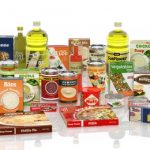Active nanocomposites refer to materials that combine nanoscale particles or additives with a matrix material to create a composite with enhanced properties and functionalities. In the context of food and beverage packaging, active nanocomposites are used to improve the quality and safety of packaged products. They offer several benefits compared to traditional packaging materials. Here’s an overview of active nanocomposites and their use in food and beverage packaging (Lagarón & Busolo, 2012):
Enhanced Barrier Properties
Active nanocomposites can provide improved barrier properties against gases, moisture, and UV radiation. Nanoscale fillers, such as clay nanoparticles or nanoscale metal oxides, are incorporated into the matrix material, forming a tortuous path that restricts the permeation of gases and moisture. This enhanced barrier performance helps to extend the shelf life of food and beverages by reducing oxidation, moisture loss, and contamination.
One of the main issues that causes immense damage to any food or beverage is the reaction by oxygen. A number of deterioration processes are known to be produced by by gas usually through autoxidation, by light induced oxidation and through aerobic microbial growth which relies on oxygen as a substrate.
Oxygen scavengers remove oxygen from the atmosphere which helps preserve a food’s quality (Follynowicz et al., 2017). It is one of a number of measures incidentally as well as gas purging with nitrogen.
Antimicrobial Properties
Active nanocomposites can possess antimicrobial properties, inhibiting the growth of bacteria, fungi, and other microorganisms. Nanoparticles with antimicrobial activity, such as silver nanoparticles or zinc oxide nanoparticles, are incorporated into the composite matrix. This helps to prevent microbial contamination and spoilage of packaged food and beverages, leading to increased safety and preservation.
The antimicrobial, nisin, has been loaded into either micro- or nanocapsules. A couple of examples used chitosan with carrageenan (Chopra et al., 2014), chitosan and alginate, alginate and cellulose, alginate and pectin and alginate with guar gum. These are all polymer composites.
As we mention later, pectin is a good nano-carrier for drugs but also nisin too (Krivorotova et al., 2016).
Intelligent Sensing and Monitoring
Active nanocomposites can incorporate nanosensors or indicators to provide real-time information about the quality or condition of packaged products. These sensors can detect changes in temperature, pH, freshness, or gas composition, providing indicators of spoilage or contamination. This helps in ensuring product quality and safety by enabling timely interventions or decision-making.
Active Release Systems
Active nanocomposites can be designed to release or absorb specific compounds or additives. Nanocarriers loaded with functional ingredients, such as antioxidants, antimicrobials, or flavor enhancers, can be incorporated into the composite matrix. The controlled release of these additives can enhance product quality, flavor, and shelf life.
Nanospheres or nanocomposites have been prepared as drug carriers; and example of an active release system. For example, drugs have been loaded into pectin nanospheres and vesicles prepared in aqueous media containing both calcium and carbonate ions which produces a very mild binding system and no emulsifier or surfactant. It’s proved a very useful model for nanocomposite performance in the body and the method is commonly used to produce pectin nanoparticles(Yu et al., 2009).
Mechanical Strength and Thermal Stability
Nanocomposites can improve the mechanical strength, flexibility, and thermal stability of packaging materials. Nanoscale fillers, such as clay nanoparticles or carbon nanotubes, reinforce the matrix material, enhancing its mechanical properties and resistance to deformation or cracking. This enables the use of thinner and lighter packaging materials without compromising their strength or functionality.
Sustainability and Waste Reduction
Active nanocomposites can contribute to sustainability efforts in packaging by reducing material usage and waste generation. The enhanced barrier properties and preservation capabilities of nanocomposites allow for extended shelf life, reducing food waste. Additionally, the use of thinner and lighter packaging materials reduces the overall environmental footprint.
The use of active nanocomposites in food and beverage packaging addresses the need for improved safety, quality, and sustainability. However, it is important to ensure the safety and regulatory compliance of these materials. Thorough testing and evaluation of nanocomposites, including toxicological assessments and migration studies, are essential to ensure the safe use of these materials for food contact applications.
References
Chopra, M., Kaur, P., Bernela, M., & Thakur, R. (2014). Surfactant assisted nisin loaded chitosan-carageenan nanocapsule synthesis for controlling food pathogens. Food Control, 37, pp. 158-164.
Foltynowicz, Z., Bardenshtein, A., Sängerlaub, S., Antvorskov, H., & Kozak, W. (2017). Nanoscale, zero valent iron particles for application as oxygen scavenger in food packaging. Food packaging and Shelf Life, 11, pp. 74-83
Krivorotova, T., Cirkovas, A., Maciulyte, S., Staneviciene, R., Budriene, S., Serviene, E., & Sereikaite, J. (2016). Nisin-loaded pectin nanoparticles for food preservation. Food Hydrocolloids, 54, pp. 49-56
Lagarón, J. M., & Busolo, M. A. (2012). Active nanocomposites for food and beverage packaging. In Emerging Food Packaging Technologies (pp. 55-65). Woodhead Publishing Ltd.
Yu, C. Y., Cao, H., Zhang, X. C., Zhou, F. Z., Cheng, S. X., Zhang, X. Z., & Zhuo, R. X. (2009). Hybrid nanospheres and vesicles based on pectin as drug carriers. Langmuir, 25(19), pp. 11720-11726


Leave a Reply